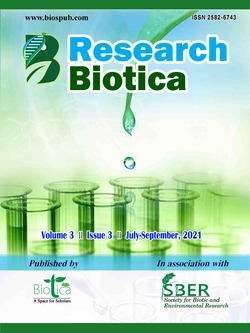
Modified Mechanical and Methodological Attributes Interplay for Isolating Antioxidant Concomitant in Herbal Materials: An Innovative Concept
Kanti Meena*
ICAR-Central Research Institute for Jute and Allied Fibres, Barrackpore, Kolkata, West Bengal (700 120), India
DOI: https://doi.org/10.54083/ResBio/3.3.2021.158-163
Keywords: Antioxidants, Bioactive compounds, Extraction processing, Therapeutics
Abstract
The plant products and materials are believed to have numerous health benefits. The Asian continent is recognized as a hub for medicinal plants. As on today, a large populace relies on medicinal plants and their associated products for the treatments of ailments. The popularity of the medicinal plants is continuously increasing because they are assumed to impose no health risk and side effects unlike synthetic therapeutants. Edible vegetals and agroindustrial residues are considered to be abundant and promising sources of natural antioxidants. The extraction method, of crucial importance for both technical and economic reasons, ideally should be non-destructive, time efficient and suitable for producing high quantities of extracts, which should be processed by selective techniques to yield concentrates of enhanced antioxidant capacity. The extraction methods, solvent system used and sample nature greatly effects the final bioactive compounds yield and efficacy. This article briefly summarized the basics of extraction and separation of bioactive compounds and improvisation in further downline applications.
Downloads
not found
Reference
Alara, O.R., Abdurahman, N.H., Ukaegbu, C.I., 2018a. Soxhlet extraction of phenolic compounds from Vernonia cinerea leaves and its antioxidant activity. Journal of Applied Research in Medicinal and Aromatic Plants 11, 1-6.
Alara, O.R., Abdurahman, N.H., Ukaegbu, C.I., Azhari, N.H., 2018b. Vernonia cinerea leaves as the source of phenolic compounds, antioxidants, and anti-diabetic activity using microwave-assisted extraction technique. Industrial Crops and Products 122, 533-544.
Balasundram, N., Sundram, K., Samman, S., 2006. Phenolic compounds in plants and agri-industrial by-products: antioxidant activity, occurrence, and potential uses. Food Chemistry 99, 191-203.
Balunas, M.J., Kinghorn, A.D., 2005. Drug discovery from medicinal plants. Life Science 78, 431-441.
Bozell, J.J., Petersen, G.R., 2010. Technology development for the production of biobased products from biorefinery carbohydrates - the US Department of Energy’s “Top 10” revisited. Green Chemistry 12, 539-554.
Cai, Z., Qu, Z., Lan, Y., Zhao, S., Ma, X., Wan, Q., Jing, P., Li, P., 2016. Conventional, ultrasound-assisted, and accelerated-solvent extractions of anthocyanins from purple sweet potatoes. Food Chemistry 197, 266-272.
Chikezie, P.C., Ojiako O.A., Nwufo, K.C., 2015. Overview of anti-diabetic medicinal plants: The Nigerian research experience. Journal of Diabetes and Metabolism 6, 546.
de Camargo, A.C., Regitano-d’Arce, M.A., Biasoto, A.C., Shahidi, F., 2016. Enzyme-assisted extraction of phenolics from winemaking by-products: antioxidant potential and inhibition of alpha-glucosidase and lipase activities. Food Chemistry 212, 395-402.
Dey, A., De, J.N., 2015. Neuroprotective therapeutics from botanicals and phytochemicals against Huntington's disease and related neurodegenerative disorders. Journal of Herbal Medicine 5, 1-19.
FSANZ, 2004. Cyanogenic glycosides in cassava and bamboo shoots: A human health risk assessment. Technical Report Series No. 28, Food Standards Australia New Zealand (FSANZ). pp. 1-78.
Garcia-Vaqueroa, M., Rajauriab, G., Tiwaria, B., 2020. Conventional extraction techniques: Solvent extraction. Sustainable Seaweed Technologies 2020, 171-189. DOI: 10.1016/B978-0-12-817943-7.00006-8.
Ghitescu, R.E., Volf, I., Carausu, C., Bühlmann, A.M., Gilca, I.A., Popa, V.I., 2015. Optimization of ultrasound-assisted extraction of polyphenols from spruce wood bark. Ultrasonics Sonochemistry 22, 535-541.
Gómez-García, R., Martínez-Ávila, G.C.G., Aguilar, C.N., 2012. Enzyme-assisted extraction of antioxidative phenolics from grape (Vitis vinifera L.) residues. Biotechnology 3(2), 297-300.
Herrero, M., Plaza, M., Cifuentes, A., Ibáñez, E., 2012. Extraction techniques for the determination of phenolic compounds in food. Comprehensive, Sampling and Sample Preparation 4, 159-180.
Joshi, V.K., Kumar, A., Kumar, V., 2012. Antimicrobial, antioxidant and phytochemicals from fruit and vegetable wastes: A review. International Journal of Food and Fermentation Technology 2, 123-136.
Lee, B.K., Kim, J.H., Jung, J.W., Choi, J.W., Han, E.S., Lee, S.H., Ho Ko, K., Ryu, J.H., 2005. Myristicin-induced neurotoxicity in human neuroblastoma SK-N-SH cells. Toxicology Letters 157, 49-56. DOI: 10.1016/j.toxlet.2005.01.012.
Liazid, A., Barbero, G., Azaroual, L., Palma, M., Barroso, C., 2014. Stability of anthocyanins from red grape skins under pressurized liquid extraction and ultrasound-assisted extraction conditions. Molecules 19(12), 21034-21043.
Meena, D.K., Sahoo, A.K., Chowdhury, H., Swain, H.S., Sahu, N.P., Behera, B.K., Srivastava, P.P., Das, B.K., 2020. Effects of extraction methods and solvent systems on extract yield, proximate composition and mineral profiling of Terminalia arjuna (Arjuna) dry powders and solvent extracts. Journal of Innovations in Pharmaceutical and Biological Sciences (JIPBS) 7(1), 22-31.
Nieto, A., Borrull, F., Pocurull, E., Marcé, R.M., 2010. Pressurized liquid extraction: A useful technique to extract pharmaceuticals and personal-care products from sewage sludge. Trends in Analytical Chemistry 29, 752-764.
Olejar, K.J., Fedrizzi, B., Kilmartin, P.A., 2015. Influence of harvesting technique and maceration process on aroma and phenolic attributes of Sauvignon blanc wine. Food Chemistry 183, 181-189.
Plaza, M., Turner, C., 2015. Pressurized hot water extraction of bioactives. Trends Analytical Chemistry 71, 39-54.
Prior, R.L., Liwei, G., 2005. Occurrence and biological significance of proanthocyanins in the American diet. Phytochemistry 66, 2264-2280.
Selvamuthukumaran, M., Shi, J., 2017. Recent advances in extraction of antioxidants from plant by-products processing industries. Food Quality and Safety 1(1), 61-81.
Shirzad, H., Niknam, V., Taheri, M., Ebrahimzadeh, H., 2017. Ultrasound-assisted extraction process of phenolic antioxidants from Olive leaves: a nutraceutical study using RSM and LC-ESI-DAD-MS. Food Science and Technology 54, 2361-2371.
Suwal, S., Marciniak, A., 2018. Technologies for the extraction, separation and purification of polyphenols - A review. Nepal Journal of Biotechnology 6, 74-91.
Tadele, Y., 2015. Important anti-nutritional substances and inherent toxicants of feeds. Food Science and Quality Management 36, 40-47.
Tsao, R., 2010. Chemistry and biochemistry of dietary polyphenols. Nutrients 2, 1231-1246.
